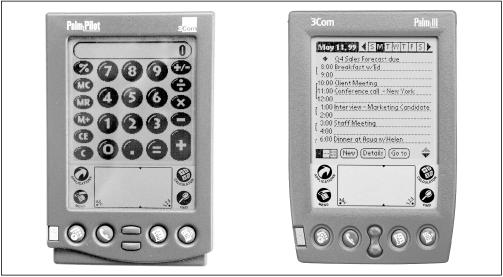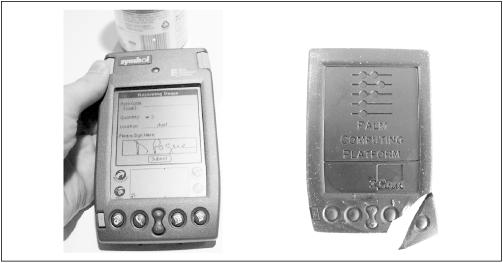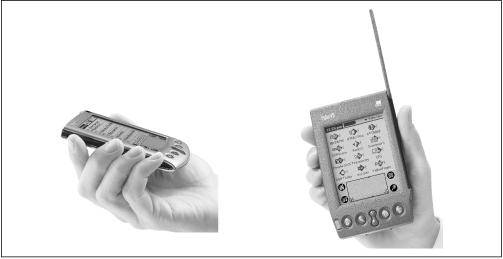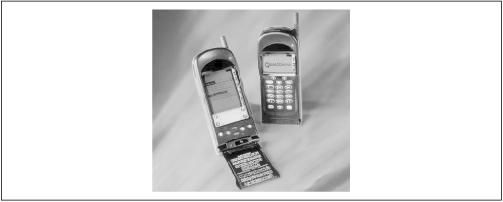The PalmPilot, like any computer, is constantly being reinvented and enhanced. Within the first three years of existence, 12 different models were available from four different companies, and the operating system had been upgraded eight times. As you read this book, and as you go on through life, identifying what model and system software you’re using will be increasingly important.
Here’s a brief guide to the history of Palm models; for more detail, tips and tricks for individual models, and a list of upgrading options, see Chapter 18.
These original models were the first to capture the world’s attention—they proved that, despite the failures of many previous gadgets from other companies, a palmtop could indeed become a mass-market best-seller.
They were boxy and limited by today’s standards (see Figure 1.6). They had non-backlit screens, had no email or Internet capability, and the less expensive model had only 128K of RAM. But the HotSync process worked like a charm, the batteries lasted forever, and absolutely nobody felt overwhelmed by the software.
The newly named PalmPilot models debuted in 1997 with backlighting, greatly enhanced built-in programs (part of Palm OS 2.0), and an Expense application. As the manufacturer relaxed about the product’s success in the business world, it also wrote four addictive games to include in the package (they’re described in Chapter 4).
The Professional model (shown in Figure 1.6) also included TCP/IP capability, so that the device could connect to company networks or the Internet, and a built-in Mail program that could transfer email to and from your desktop computer via HotSync (see Chapter 13, for details). Its generous 1MB of memory made room for all this extra data.
The 1998 model’s name was the first to omit the word Pilot, although millions of befuddled fans still continue to use the word Pilot or PalmPilot to describe all of these palmtops (as this book does). Its primary features were infrared beaming (see Chapter 15), a new operating system (3.0) that included a choice of fonts for each program, and two megabytes of memory. All of this came in a sleeker, more tapered case (see Figure 1.6)—with a flip-up lid.
Selling its devices under the name WorkPad, IBM makes black, not gray, editions of the Palm III, Palm IIIx, and Palm V. Except for the case color, they’re identical to their Palm Computing counterparts.
Symbol Technologies (http://www.symbol.com/palm) makes portable barcode-reading machines. It’s only natural, then, that the company would be attracted to the potential of the PalmPilot’s sleek shape and sharp features. The result is the Symbol SPT1500, an extended Palm III whose extra height houses a laser-beam barcode reader (see Figure 1.7).
1999’s Palm IIIx is almost identical to the Palm III—at least as far as the software and workings are concerned. But the Palm IIIx has twice the memory (a total of 4MB), a much sharper screen, and a more rugged design. It’s also based on a new processor, the Motorola Dragonball EZ, which opens the way for less expensive memory upgrades down the road.
The expensive, gorgeous, ultra-thin Palm V is the first PalmPilot to be housed in brushed aluminum, not plastic (see Figure 1.8). As with the Palm IIIx, there aren’t any new features to distinguish the software—but the hardware story is exciting enough. This model is half as thick, half an inch shorter, and 25% lighter than previous models.
Figure 1-8. The Palm V, left, is the smallest Palm device yet. The Palm VII, right, is slightly taller than a standard PalmPilot, thanks to its built-in two-way radio circuitry.
The built-in lithium-ion battery recharges whenever the device is sitting in its HotSync cradle; Palm V owners never buy AAA batteries. The device runs for a month on a single charge, and one HotSync a day is enough time in the cradle to keep it full. Meanwhile, the Palm V’s screen is the best ever to appear on a PalmPilot, better even than the Palm IIIx screen.
Unfortunately, the redesigned, power-drawing HotSync jack makes the Palm V incompatible with many of the HotSync-port add-on gadgets described earlier in this chapter, such as the vibrator and GPS receiver. (Adapters will soon be available.) And when the Palm V is carried in a tight shirt pocket, its raised scroll buttons have a tendency to turn the machine on and start chattering as pressure holds them down. Otherwise, though, the Palm V is every bit the status-symbol PalmPilot the manufacturer intended.
Before the Palm VII, there were ways to surf the Internet without being plugged into a phone line. You could buy a wireless modem for your laptop or PalmPilot. You could attach the proper cables, sign up for the proper $50-per-month service, and say the proper prayers.
But the Palm VII is the first all-in-one, no-cables-necessary, ready-to-use wireless gizmo to take the world by storm. Only half an inch taller than the standard PalmPilot (see Figure 1.8), the VII’s flip-up antenna instantly turns the device on. For $10 per month, you can now send or receive wireless email, or query specific web sites for useful data (such as weather, sports, news, stock quotes, cash-machine locations, flight schedules, package-tracking info, phone numbers from the White Pages, local movie showtimes, and so on). Details on these wireless features are in Chapter 16.
Except for its two new applications—iMessenger for email, Clipper for web queries—the Palm VII’s software is otherwise identical to that of the Palm III, IIIx, and V. The engineering surprise is the built-in NiCad battery (which accounts for the extra height), which helps to counter the power drain of the built-in two-way radio.
What do you get when you cross the PalmPilot with a cell phone? The Qualcomm pdQ SmartPhone (see Figure 1.9). The Palm screen is nestled in the handset, so that the circuitry can dial, or send email to or visit the web site of anyone in your Address Book program. The device is a full-fledged PalmPilot otherwise, complete with a HotSync cradle and the usual built-in software. (For a full discussion of the email and web programs built into the SmartPhone, see Chapter 13 and Chapter 14. And see Chapter 18 for more detail on this gadget and all the others described in this section.)
July 1999 saw Palm’s low-cost answer to the cheap Palm knockoffs that rival manufacturers had introduced: The Palm IIIe. The new model offers the same size, shape, features, and sharp screen as its sibling, the Palm IIIx.
The IIIe’s three dramatic differences: first, it lacks the IIIx’s expansion slot; second, it has only 2MB of RAM; and third, the price hit a new Palm low: $179. For the vast majority of Palm owners who never upgrade their machines, the IIIe is an economical option.
In 1998, PalmPilot inventor Jeff Hawkins left Palm to found a rival palmtop maker called Handspring (http://www.handspring.com). The technology world held its breath. What could top the elegant simplicity design of his first creation? What could Hawkins and his team possibly build for an encore?
The answer: a PalmPilot clone. In most regards, Handspring’s weirdly named Visor is identical to a PalmPilot. It uses the same OS, can run the same add-on programs, and sports the same four buttons that launch your calendar, phone book, to do list, or memo pad. Everything in this book, and all the software on the CD, works on the Visor.
But the Visor is noticeably faster than Palm devices; it includes beefed-up Date Book and Calculator programs; its HotSync cradle has a USB connector, meaning faster HotSync times and convenience for Mac users; and, above all, it features an expansion slot on the back half of the device. Into this space you can insert what’s called a Springboard module—a black plastic cartridge that contains its own self-launching, self-configuring software. Due in 2000, according to Handspring, are a modem, wireless modem, pager, Bluetooth wireless network module, digital camera, thermometer, MP3 player, GPS (global positioning satellite) receiver, voice recorder, cell phone, and so on. The irony is delicious: Among the features Hawkins stubbornly resisted putting into the original Pilot, in the name of simplicity and low cost, was an expansion slot—which is the Visor’s biggest selling point.
The Visor’s price is its other breakthrough feature: $149 without a HotSync cradle, $179 with, and $249 for the 8MB Deluxe model.
Get PalmPilot: The Ultimate Guide, Second Edition now with the O’Reilly learning platform.
O’Reilly members experience books, live events, courses curated by job role, and more from O’Reilly and nearly 200 top publishers.





